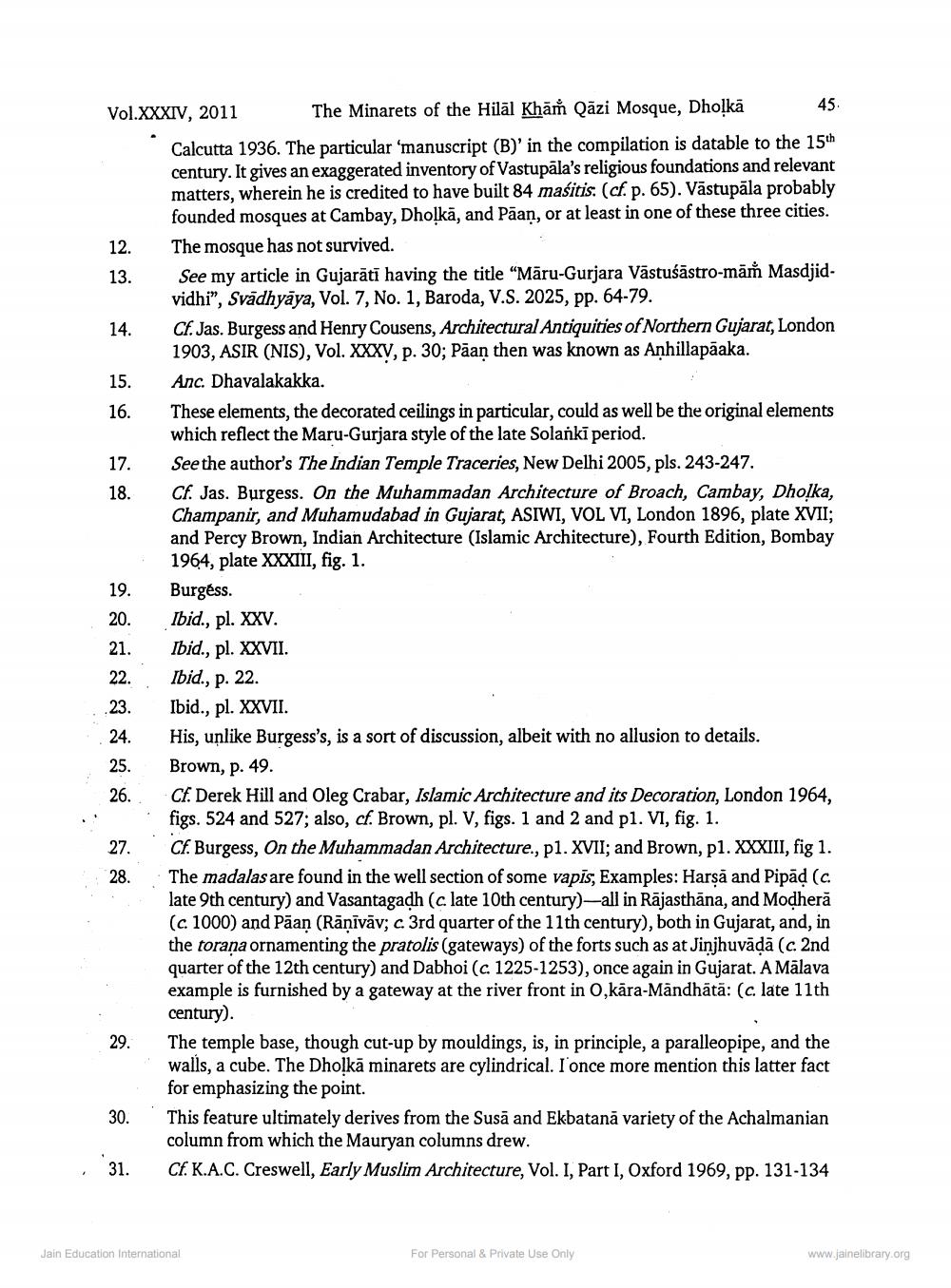________________
Vol.XXXIV, 2011
The Minarets of the Hilal Khämh Qazi Mosque, Dholka
45.
Calcutta 1936. The particular 'manuscript (B)' in the compilation is datable to the 15th century. It gives an exaggerated inventory of Vastupala's religious foundations and relevant matters, wherein he is credited to have built 84 masitis. (cf. p. 65). Västupala probably founded mosques at Cambay, Dholka, and Päan, or at least in one of these three cities. The mosque has not survived.
12.
13.
14.
15.
16.
17.
18.
2 2 2 2 2 2 2 2
19.
20.
21.
22.
23.
24.
25.
26.
27.
28.
29.
30.
31.
See my article in Gujarati having the title "Märu-Gurjara Västuśästro-märħ Masdjidvidhi", Svadhyaya, Vol. 7, No. 1, Baroda, V.S. 2025, pp. 64-79.
Cf. Jas. Burgess and Henry Cousens, Architectural Antiquities of Northern Gujarat, London 1903, ASIR (NIS), Vol. XXXV, p. 30; Päan then was known as Anhillapäaka.
Anc. Dhavalakakka.
These elements, the decorated ceilings in particular, could as well be the original elements which reflect the Maru-Gurjara style of the late Solanki period.
See the author's The Indian Temple Traceries, New Delhi 2005, pls. 243-247.
Cf. Jas. Burgess. On the Muhammadan Architecture of Broach, Cambay, Dholka, Champanir, and Muhamudabad in Gujarat, ASIWI, VOL VI, London 1896, plate XVII; and Percy Brown, Indian Architecture (Islamic Architecture), Fourth Edition, Bombay 1964, plate XXXIII, fig. 1.
Burgess.
Ibid., pl. XXV.
Ibid., pl. XXVII.
Ibid., p. 22.
Ibid., pl. XXVII.
His, unlike Burgess's, is a sort of discussion, albeit with no allusion to details.
Brown, p. 49.
Cf. Derek Hill and Oleg Crabar, Islamic Architecture and its Decoration, London 1964, figs. 524 and 527; also, cf. Brown, pl. V, figs. 1 and 2 and p1. VI, fig. 1.
Cf. Burgess, On the Muhammadan Architecture., pl. XVII; and Brown, pl. XXXIII, fig 1. The madalas are found in the well section of some vapis, Examples: Harsa and Pipad (c. late 9th century) and Vasantagadh (c late 10th century)-all in Rajasthāna, and Modhera (c. 1000) and Paan (Räniväv; c. 3rd quarter of the 11th century), both in Gujarat, and, in the torana ornamenting the pratolis (gateways) of the forts such as at Jinjhuvādā (c. 2nd quarter of the 12th century) and Dabhoi (c. 1225-1253), once again in Gujarat. A Mālava example is furnished by a gateway at the river front in O,kara-Mandhātā: (c. late 11th century).
The temple base, though cut-up by mouldings, is, in principle, a paralleopipe, and the walls, a cube. The Dholka minarets are cylindrical. I'once more mention this latter fact for emphasizing the point.
This feature ultimately derives from the Susã and Ekbatană variety of the Achalmanian column from which the Mauryan columns drew.
Cf. K.A.C. Creswell, Early Muslim Architecture, Vol. I, Part I, Oxford 1969, pp. 131-134
Jain Education International
For Personal & Private Use Only
www.jainelibrary.org




